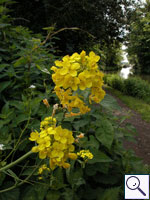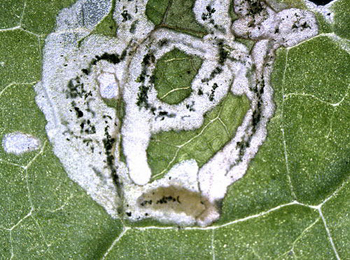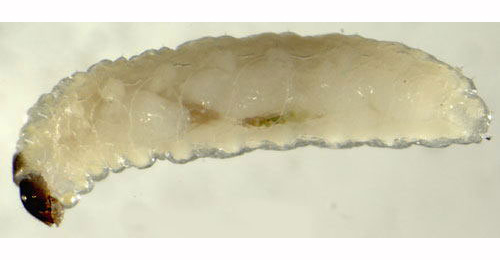 |
| |
(Coleoptera, Diptera, Hymenoptera and Lepidoptera)
by
Brian Pitkin, Willem Ellis, Colin Plant and Rob Edmunds
|
|
|
BRASSICA.
Cabbage, Mustard, Rape and Turnip. [Brassicaceae]
|
Eleven
species of Brassica are recorded in Britain. These include
the native Black Mustard (B. nigra) and Wild Cabbage (B.
oleracea). A further nine species of Brassica have been
introduced, including Ethiopian Rape, (B. carinata), Long-stalked
Rape (B. elongata), Chinese Mustard (B. juncea), Rape
(B. napus), Turnip (B. rapa) and Pale Cabbage (B.
tournefortii). The BSBI provide a downloadable plant crib for Brassicaceae.
Seven British miners are recorded on Brassica.
The
agromyzid Phytomyza
varipes is recorded feeding in the seed-heads of Brassica in Britain (Sepncer, 1972), although he later records the host of
this species as Rhinanthus [Scrophulariaceae] and not Brassica (Spencer, 1990).
Although
the anthomyiids Botanophila
fugax and Delia
florilega have has been recorded on Brassica, they
are not strictly miners.
A key to the European miners recorded on Brassica is provided in Bladmineerders van Europa. |

Brassica sp. |
Key for the identification of the known mines of British
insects (Diptera and non-Diptera) recorded on Brassica
|
1a > Leaf and stem mine: Oviposition takes place in the leaf blade where a short mine is
formed until the larva reaches the nearest vein which is then followed
downwards, with the main feeding occurring in the mid-rib, petiole,
or in young plants, also in the stem (Spencer,
1976: 490). Pupation either internal or external.
The
mine begins somewhere in the leaf, generally at the lower surface,
not far from the leaf margin. From there a corridor runs randomly,
until it hits upon a vein. The corridor then follows this vein until
it reaches the midrib. Then the larva starts to bore into the midrib,
and may descend into the petiole or even the stem. Pupation may
take place either within or outside the mine. |
On Brassica in Britain and additional genera of Brassicaceae
elsewhere. Widespread but only recorded from Warwick, Dunbarton
and East Lothian in Britain. Also recorded in the Republic of
Ireland, continental Europe, Egypt, Canada and the U.S.A.
|
Phytomyza
rufipes Meigen, 1830 [Diptera: Agromyzidae].
|
1b > Leaf-miner: A distinctive mine primarily above mid-rib, with irregular short
lateral offshoots into leaf blade. Pupation external (Spencer, 1972:
51 (fig. 172), 55; Spencer, 1976:
270, 271 (fig. 486)).
Branched,
whitish, upper-surface corridor; main axis overlying the midrib;
side branches overlying the main lateral veins. (In Campanula and Phyteuma the mine is much less branched, sometimes nothing
more than a corridor on top of the midrib). Frass in rather long
strings. Usually the mines begins as a long and narrow, shallow,
tortuous lower-surface corridor that ends upon the midrib but otherwise
is not associated with the leaf venation. Often this initial corridor
is filled with callus, and then even less conspicuous. Pupation
outside the mine.
A
linear mine on the upper surface, usually following the midrib and
showing side branches along the veins. The frass is in strings. |
|
|
| Polyphagous. On more than 40 host genera in 15 families, including Brassica in Britain. Widespread
throughout Britain. Also recorded in the Republic of Ireland.
Widespread in continental Europe. |
Liriomyza strigata (Meigen, 1830) [Diptera: Agromyzidae]. |
1f > Leaf-miner: Corridor-blotch mine, normally dorsal; usually whitish; in small
leaves it lies characteristically in the centre of the leaf often
touching the petiole; in larger leaves it lies to one side of the
mid-rib. Frass deposited in green clumps near the leaf margin. Pupation
usually external, sometimes in a separate pupation mine |
|
|
Polyphagous. On
numerous genera of Brassicaceae, Asteraceae, Papaveraceae, Resedaceae,
Tropaeolaceae and Violaceae, including Alliaria, Barbarea, Brassica, Cheiranthus, Cochlearia, Coincyia, Conringia, Diplotaxis, ? Eruca, Erysimum, ? Hesperis. Lepidium, Matthiola, Raphanus, ? Rorippa and Sinapis in Britain. On additional genera of these families and Fabaceae elsewhere. Widespread, from Caithness in the north to Cornwall in the south of Britain. Also recorded in the Republic of Ireland, Europe, the East Palaearctic, Near East and Neartic Region.
|
Scaptomyza flava (Fallén, 1823) [Diptera: Drosophilidae]. |
1g > Leaf-miner: Narrow
corridor, leading to a large blotch. The blotch has lower- and upper-surface
parts, and is full depth where these overlap. Pupation external
(Robbins, 1991a). |
On
? Brassica, ? Sisymbrium, Stellaria and Potamogeton in Britain and ? Stellaria elsewhere, Widespread from Caithness in the north to Kent in the
south-east of Britain. Widespread in continental Europe.
|
Scaptomyza
griseola (Zetterstedt, 1847) [Diptera: Drosophilidae]. |
1h > Leaf-miner: Mine linear, whitish, both upper and lower surface. Pupation internal,
at the end of the mine with the anterior spiracles projecting through
the epidermis (Spencer, 1976:
433).
Upper-surface,
less often lower-surface corridor. Frass in isolated grains. Pupation
within the mine, usually in a lower-surface puparial chamber.
A long whitish upper surface corridor, which eventually goes lower surface. |
|
|
Two
highly polyphagous species of Chromatomyia, with indistinguishable
mines, have been recorded in Britain. These are syngenesiae (Hardy) and horticola (Goureau) which can only be distinguished by the male genitalia. Both species are widespread in Britain and elsewhere, although syngenesiae is almost entirely restricted to Asteraceae. Records on Asteraceae not based on examination of male genitalia are treated in this account as Chromatomyia 'atricornis'.
Chromatomyia
horticola is recorded on 160 plant genera in 31 families of which 55 plant
genera in 19 families, including Brassica, in Britain.
|
Chromatomyia
horticola (Goureau, 1851) [Diptera: Agromyzidae]. |
1i > Leaf-miner: Rather small, untidy, full depth, often branched corridor, often close to the leaf margin. Sides irregularly eaten out. Frass in a greyish-green central line that is interrupted from time to time, sometimes partly in strings. In times of rain the frass may run out and appear greenish.
Usually several mines in a leaf. The larva is rather shapeless, with a well-sclerotised head. The body is whitish; head greyish brown with Y-shaped lighter marking. Pronotum with a pair of brownish shields. The mandibles have two teeth. |

Mine
of Ceutorhynchus minutus on Raphanus sativus
Image: © Willem Ellis (Bladmineerders van Europa) |

Ceutorhynchus minutus larva, lateral
Image: © Willem Ellis (Bladmineerders van Europa) |
Polyphagous. On numerous genera and species of Brassicaceae, Capparaceae, Resedaceae and Tropaeolaceae, including Cochlearia, but not yet on Brassica, in Britain and numerous Brassicaceae, including Brassica, elsewhere. Widespread in Britain and continental
Europe. Also recorded in the Republic of Ireland.
|
Ceutorhynchus
minutus (Marsham, 1802) [Coleoptera: Curculionidae]. |
1j > Leaf-miner: In the first instar the larva mines the leaves, forming short,
irregular, blotch-like mines, but in later instars it lives externally,
feeding in spun leaves and often twisting those of tender shoots. Larval head light-brown or yellowish brown, edged with black postero-laterally,
ocellar area blackish; prothoracic plate black edged with whitish
anteriorly; abdomen dull dark green; pinacula distinct, black,
sometimes brownish but with black bases to setae; anal plate large,
black (Bradley et al., 1973).
Small,
full depth mine without a definite shape; little frass. Some silk
is deposited in the mine. The larva soon leaves the mine and continues
feeding among spun leaves. |
Polyphagous. On numerous genera and species of several plant families, but not yet on Brassica, in Britain and elsewhere. Widespread in
Britain and continental Europe. Also recorded from the Channel
Is.
|
Cnephasia
incertana (Treitschke, 1835) [Lepidoptera: Tortricidae]. |
|
|